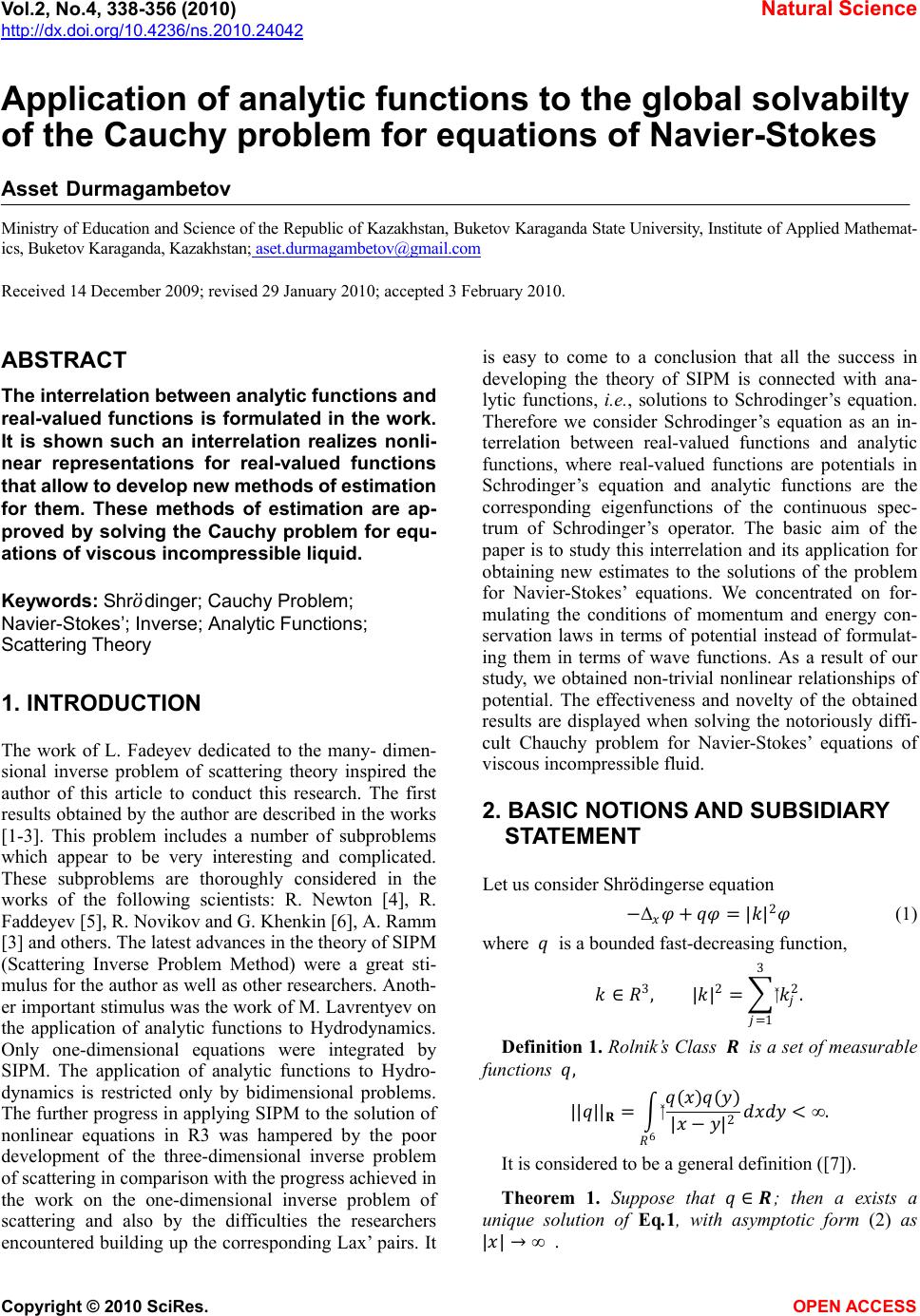 Vol.2, No.4, 338-356 (2010) Natural Science http://dx.doi.org/10.4236/ns.2010.24042 Copyright © 2010 SciRes. OPEN ACCESS Application of analytic functions to the global solvabilty of the Cauchy problem for equations of Navier-Stokes Asset Durmagambetov Ministry of Education and Science of the Republic of Kazakhstan, Buketov Karaganda State University, Institute of Applied Mathemat- ics, Buketov Karaganda, Kazakhstan; aset.durmagambetov@gmail.com Received 14 December 2009; revised 29 January 2010; accepted 3 February 2010. ABSTRACT The interrelation between analytic functions and real-valued functions is formulated in the work. It is shown such an interrelation realizes nonli- near representations for real-valued functions that allow to develop new methods of estimation for them. These methods of estimation are ap- proved by solving the Cauchy problem for equ- ations of viscous incompressible liquid. Keywords: Shrdinger; Cauchy Problem; Navier-Stokes’; Inverse; Analytic Functions; Scattering Theory 1. INTRODUCTION The work of L. Fadeyev dedicated to the many- dimen- sional inverse problem of scattering theory inspired the author of this article to conduct this research. The first results obtained by the author are described in the works [1-3]. This problem includes a number of subproblems which appear to be very interesting and complicated. These subproblems are thoroughly considered in the works of the following scientists: R. Newton [4], R. Faddeyev [5], R. Novikov and G. Khenkin [6], A. Ramm [3] and others. The latest advances in the theory of SIPM (Scattering Inverse Problem Method) were a great sti- mulus for the author as well as other researchers. Anoth- er important stimulus was the work of M. Lavrentyev on the application of analytic functions to Hydrodynamics. Only one-dimensional equations were integrated by SIPM. The application of analytic functions to Hydro- dynamics is restricted only by bidimensional problems. The further progress in applying SIPM to the solution of nonlinear equations in R3 was hampered by the poor development of the three-dimensional inverse problem of scattering in comparison with the progress achieved in the work on the one-dimensional inverse problem of scattering and also by the difficulties the researchers encountered building up the corresponding Lax’ pairs. It is easy to come to a conclusion that all the success in developing the theory of SIPM is connected with ana- lytic functions, i.e., solutions to Schrodinger’s equation. Therefore we consider Schrodinger’s equation as an in- terrelation between real-valued functions and analytic functions, where real-valued functions are potentials in Schrodinge r’s equation and analytic functions are the corresponding eigenfunctions of the continuous spec- trum of Schrodinger’s operator. The basic aim of the paper is to study this interrelation and its application for obtaining new estimates to the solutions of the problem for Navier-Stokes’ equations. We concentrated on for- mulating the conditions of momentum and energy con- servation laws in terms of potential instead of formulat- ing them in terms of wave functions. As a result of our study, we obtained non-trivial nonlinear relationships of potential. The effectiveness and novelty of the obtained results are displayed when solving the notoriously diffi- cult Chauchy problem for Navier-Stokes’ equations of viscous incompressible fluid. 2. BASIC NOTIONS AND SUBSIDIARY STATEMENT Let us consider Shrodingerse equation Δ+= ||2 (1) where is a bounded fast-decreasing function, 3,||2= 3 =1 2. Definition 1. Rolnik’s Class is a set of measurable functions , ||||= 6()() ||2<∞. It is considered to be a general definition ([7]). Theorem 1. Suppose that ; then a exists a unique solution of Eq.1, with asymptotic form (2) as ||∞ .  A. Durmagambetov / Natural Science 2 (2010) 338-356 339 Copyright © 2010 SciRes. OPEN ACCESS ±(,)= (,)+ +±|||| ||±(,)+0 1 || (2) where 3,= || ||, (,) = 3 =1 , ±(,) =1 (2)3 3()±(,)(,). The proof of this theorem is in [7]. Consider the operators = +(), 0= defined in the dense set 2 2(3) in the space 2(3). The operator is called Schrodinger’s operator. Povz- ner [8] proved that the functions ± (,) form a complete orthonormal system of eigenfunctions of the continuous spectrum of the operator , and the operator fills up the whole positive semi-axis. Besides the conti- nuous spectrum the operator can have a finite num- ber of negative eigenvalues Denote these eigenvalues by 2 and conforming normalized egenfunctions by (,2)(=1, ), where (,2)2(3). Theorem 2 (About Completeness). For any vec- tor-function 2(3) and eigenfunctions of the op- erator , we have Parseval’s identity ||2 2= =1 ||2+ 3|()|2, where and are Fourier coefficients in case of dis- crete of and continuous spectrum respectively. The proof of this theorem is in [8]. Theorem 3 (Birman - Schwinger’s Estimate). Sup- pose . Then the number of discrete eigenvalues of Shrdinger operator satisfies the estimate ()1 (4)2 3 3()() ||2. The proof of this theorem is in [9]. Definition 2. [7] ±(,) =1 (2)3 3±(,)(,)(). ±(.,.) is called T-matrix. Let us take into consider- ation a series for ±: ±(,)= =0 ±(,), where 0±(,)=1 (2)3 3(,)(), ±(,)=1 (2)3 (1) (4) 3(+1) (,0) ×(0)±|||01| |01|(1)...(1) ×±|||1| |1|()(,)0.... As well as in [7] we formulate. Definition 3. Series (4) is called Born’s series. Theorem 4. Let 1(3) . If 24, then Born’s series for (,) converges as ,3. The proof of the theorem is in [7]. Definition 4. Suppose ; then the function (,), denoted by the following equality (,)=1 (2)3 3() +(,)(,), is called scattering amplitude Corollary 1. Scattering amplitude (,) is equal to -matrix (,) =+(,) =1 (2)3 3()+(,)(,). The proof follows from definition 4. It is a well-known fact [5] that the solutions + (,) and (,) of Eq.1 are linearly dependent += (3) where is a scattering operator with the nucleus (,) of the form (,)= 3+(,)+ (,). Theorem 5. (Conservation Law of Impulse and Energy). Assume that , then =,=, where is anunit operator. The proof is in [5]. Let us use the following definitions ()= 3()(,), ()= 3()(,), mv () = 3())(||2||2), 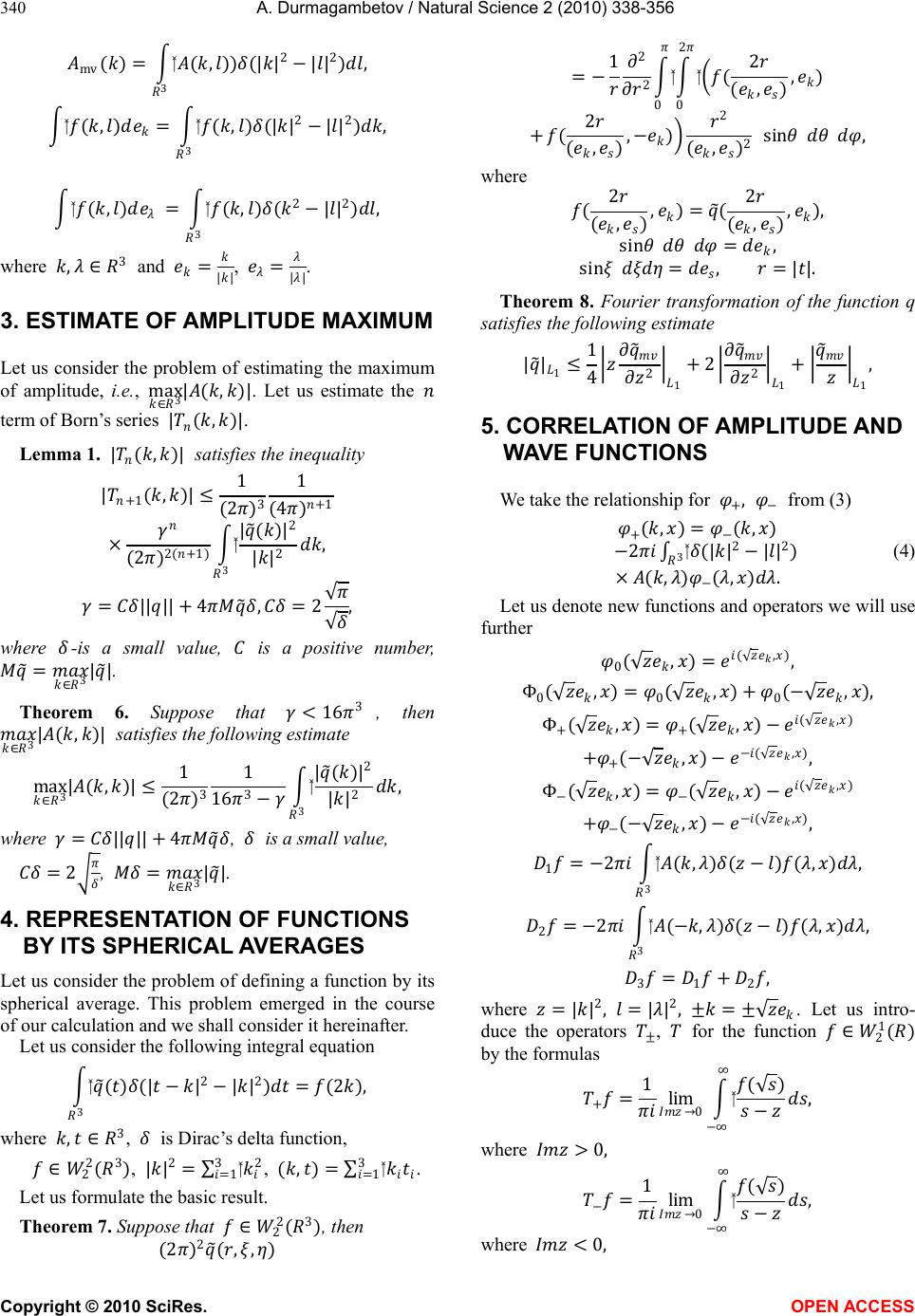 340 A. Durmagambetov / Natural Science 2 (2010) 338-356 Copyright © 2010 SciRes. OPEN ACCESS mv () = 3(,))(||2||2), (,)= 3(,)(||2||2), (,) = 3(,)(2||2), where ,3 and = ||, = ||. 3. ESTIMATE OF AMPLITUDE MAXIMUM Let us consider the problem of estimating the maximum of amplitude, i.e., max 3|(,)|. Let us estimate the term of Born’s series |(,)|. Lemma 1. |(,)| satisfies the inequality |+1 (,)| 1 (2)3 1 (4)+1 × (2)2(+1) 3 |()|2 ||2, =|||| + 4,=2 , where -is a small value, is a positive number, = 3||. Theorem 6. Suppose that <163, then 3|(,)| satisfies the following estimate max 3|(,)| 1 (2)3 1 163 3 |()|2 ||2, where =|||| + 4, is a small value, = 2 , = 3||. 4. REPRESENTATION OF FUNCTIONS BY ITS SPHERICAL AVERAGES Let us consider the problem of defining a function by its spherical average. This problem emerged in the course of our calculation and we shall consider it hereinafter. Let us consider the following integral equation 3()(||2||2)=(2), where ,3, is Dirac’s delta function, 2 2(3), ||2= 3 =1 2, (,) = 3 =1 . Let us formulate the basic result. Theorem 7. Suppose that 2 2(3), then (2)2(,,) =1 2 2 0 2 0(2 (,),) +(2 (,),)2 (,)2 sin , where (2 (,),)= (2 (,),), sin =, sin =,= ||. Theorem 8. Fourier transformation of the function q satisfies the following estimate ||11 4 21 +2 21 + 1 , 5. CORRELATION OF AMPLITUDE AND WAVE FUNCTIONS We take the relationship for +, from (3) +(,)=(,) 2 3(||2||2) (4) ×(,)(,). Let us denote new functions and operators we will use further 0(,)=(,), 0(,) =0(,) + 0(,), +(,) =+(,)(,) ++(,)(,), (,) =(,)(,) +(,)(,), 1=2 3(,)()(,), 2=2 3(,)()(,), 3=1+2, where = ||2,= ||2, ±= ±. Let us intro- duce the operators ±, for the function 2 1() by the formulas +=1 lim 0 () , where > 0, =1 lim 0 () , where < 0, 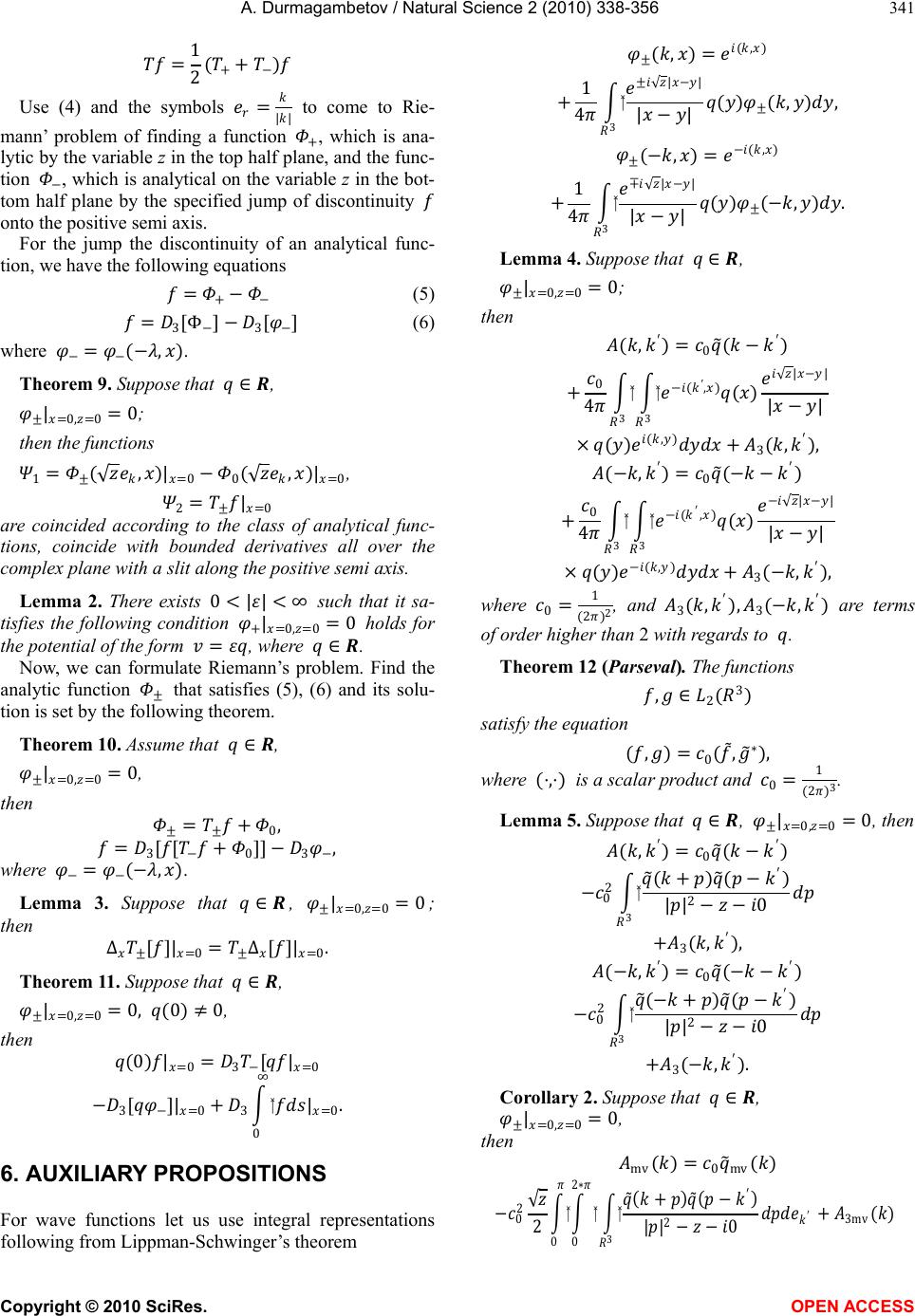 A. Durmagambetov / Natural Science 2 (2010) 338-356 341 Copyright © 2010 SciRes. OPEN ACCESS =1 2(++) Use (4) and the symbols = || to come to Rie- mann’ problem of finding a function +, which is ana- lytic by the variable z in the top half plane, and the func- tion , which is analytical on the variable z in the bot- tom half plane by the specified jump of discontinuity onto the positive semi axis. For the jump the discontinuity of an analytical func- tion, we have the following equations =+ (5) =3[]3[] (6) where =(,). Theorem 9. Suppose that , ±|=0,=0 =0; then the functions 1=±(,)|=0 0(,)|=0, 2=±|=0 are coincided according to the class of analytical func- tions, coincide with bounded derivatives all over the complex plane with a slit along the positive semi axis. Lemma 2. There exists 0 <|| < such that it sa- tisfies the following condition +|=0,=0= 0 holds for the potential of the form =, where . Now, we can formulate Riemann’s problem. Find the analytic function ± that satisfies (5), (6) and its solu- tion is set by the following theorem. Theorem 10. Assume that , ±|=0,=0 =0, then ±=±+0, =3[[+0]] 3, w here =(,). Lemma 3. Suppose that , ±|=0,=0 =0; then ±[]|=0=±[]|=0. Theorem 11. Suppose that , ±|=0,=0 =0, (0) 0, then (0)|=0=3[|=0 3[]|=0 +3 0|=0. 6. AUXILIARY PROPOSITIONS For wave functions let us use integral representations following from Lippman-Schwinge r’s theorem ±(,)= (,) +1 4 3±|| ||()±(,), ±(,) = (,) +1 4 3|| ||()±(,). Lemma 4. Suppose that , ±|=0,=0 =0; then (,) =0() +0 4 3 3(′,)()|| || ×()(,)+3(,), (,)=0() +0 4 3 3(,)()|| || ×()(,)+3(,), where 0=1 (2)2, and 3(,), 3(,) are terms of order higher than 2 with regards to . Theorem 12 (Parseval). The functions ,2(3) satisfy the equation (,) =0(,), where (,) is a scalar product and 0=1 (2)3. Lemma 5. Suppose that , ±|=0,=0= 0, then (,)=0() 0 2 3(+)() ||20 +3(,), (,)=0() 0 2 3(+)() ||20 +3(,). Corollary 2. Suppose that , ±|=0,=0 =0, then mv () =0mv () 0 2 2 0 2 0 3 (+)( ) || 2 0 + 3mv () 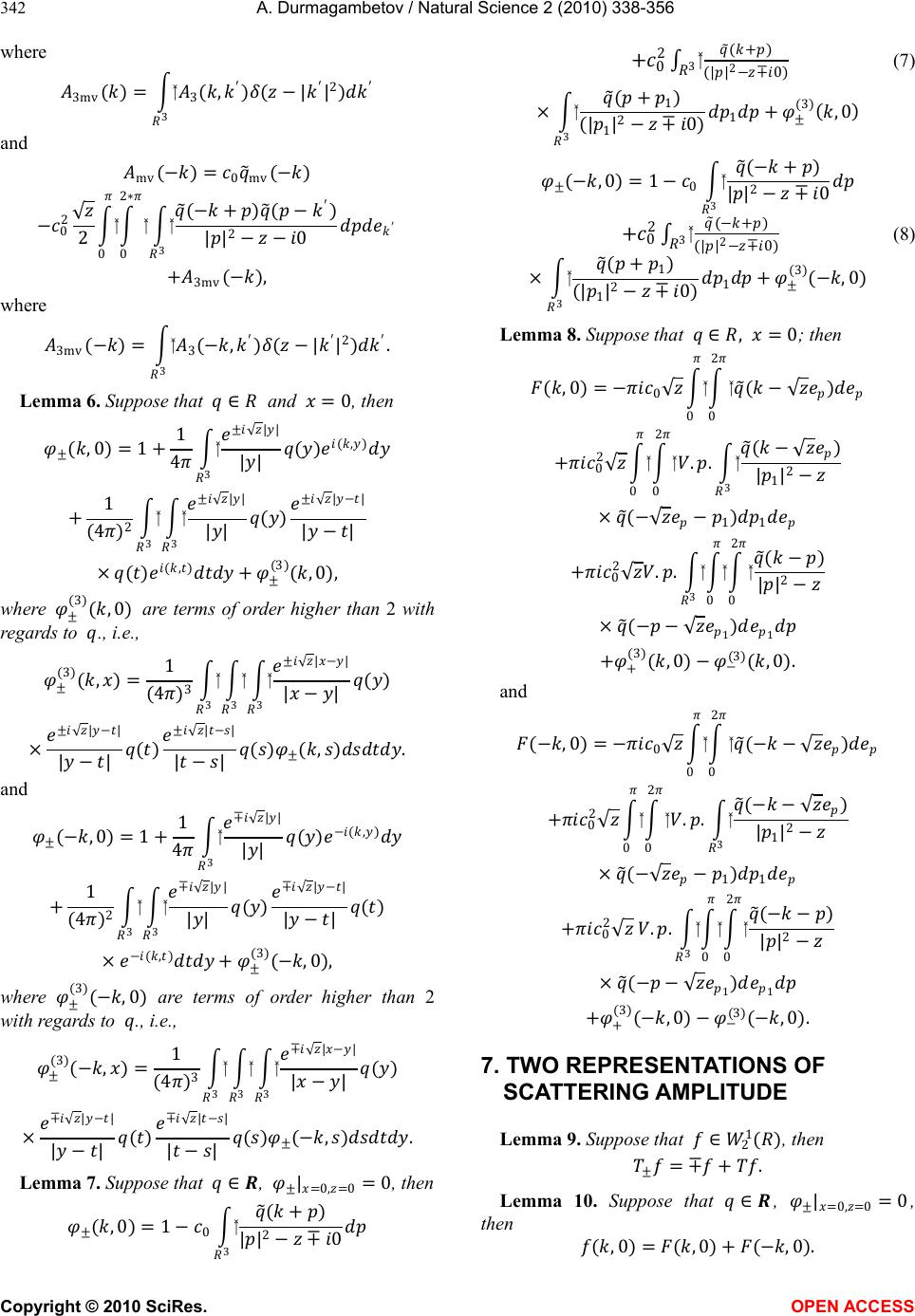 342 A. Durmagambetov / Natural Science 2 (2010) 338-356 Copyright © 2010 SciRes. OPEN ACCESS where 3mv ()= 33(,)(||2) and mv () = 0mv () 0 2 2 0 2 0 3(+)() ||20 +3mv (), where 3mv () = 33(,)(||2). Lemma 6. Suppose that and = 0, then ±(, 0)=1+1 4 3±|| ||()(,) +1 (4)2 3 3±|| ||()±|| || ×()(,)+± (3)(, 0), where ± (3)(, 0) are terms of order higher than 2 with regards to ., i.e., ± (3)(,)=1 (4)3 3 3 3±|| ||() ×±|| ||()±|| ||()±(,). and ±(, 0)=1+1 4 3|| ||()(,) +1 (4)2 3 3|| ||()|| ||() ×(,)+± (3)(, 0), where ± (3)(, 0) are terms of order higher than 2 with regards to ., i.e., ± (3)(,) =1 (4)3 3 3 3|| ||() ×|| ||()|| ||()±(,). Lemma 7. Suppose that , ±|=0,=0= 0, then ±(, 0)=10 3(+) ||20 +0 2 3(+) (||20) (7) × 3(+1) (|1|20) 1+± (3)(, 0) ±(, 0)=10 3(+) ||20 +0 2 3(+) (||20) (8) × 3(+1) (|1|20) 1+± (3)(, 0) Lemma 8. Suppose that , = 0; then (, 0)=0 0 2 0() +0 2 0 2 0.. 3() |1|2 ×(1)1 +0 2.. 3 0 2 0 () ||2 ×(1)1 ++ (3)(, 0) (3)(, 0). and (, 0)=0 0 2 0() +0 2 0 2 0.. 3() |1|2 ×(1)1 +0 2 .. 3 0 2 0 () ||2 ×(1)1 ++ (3)(, 0) (3)(, 0). 7. TWO REPRESENTATIONS OF SCATTERING AMPLITUDE Lemma 9. Suppose that 2 1(), then ±=+. Lemma 10. Suppose that , ±|=0,=0= 0, then (, 0)=(, 0)+(, 0). 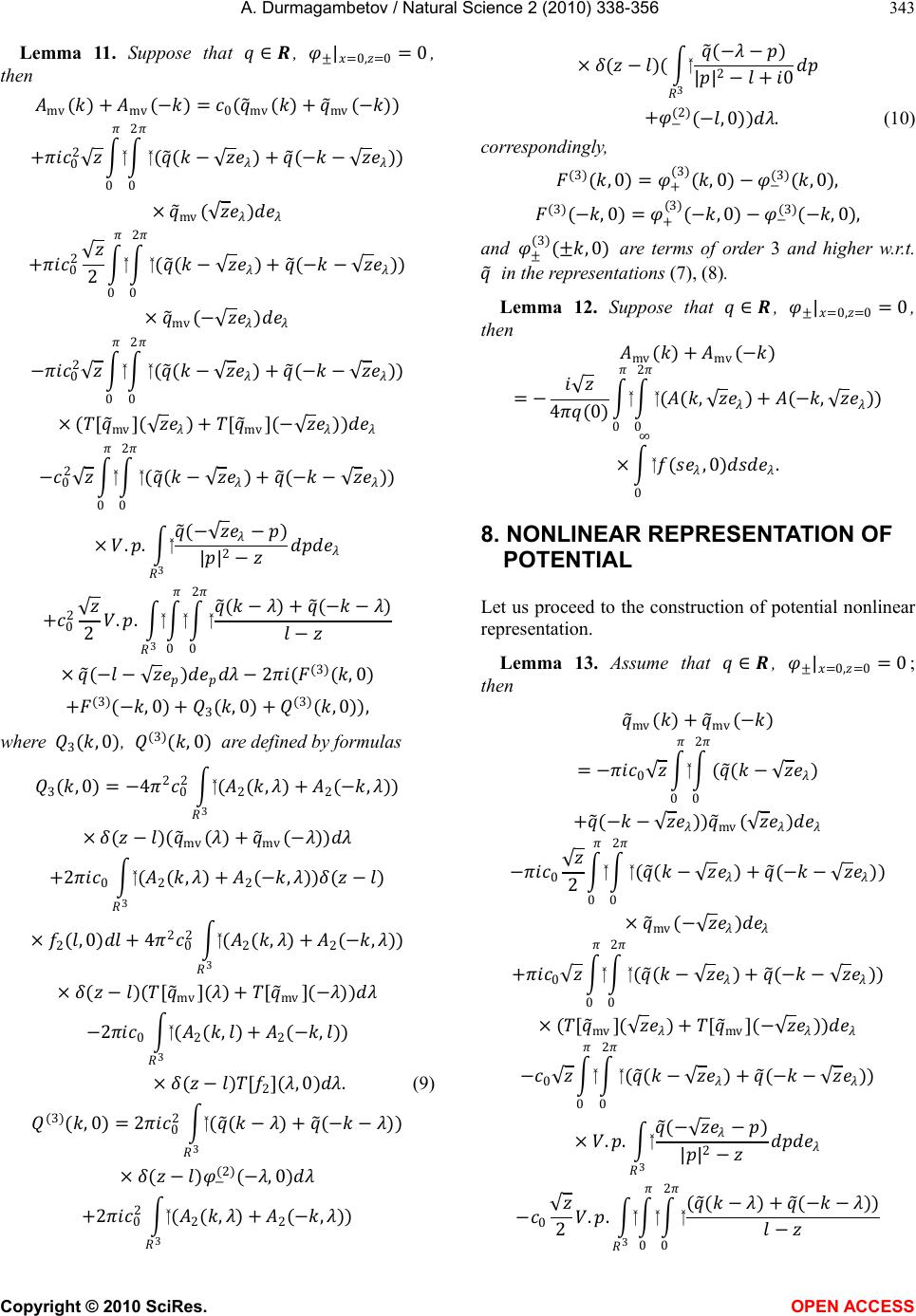 A. Durmagambetov / Natural Science 2 (2010) 338-356 343 Copyright © 2010 SciRes. OPEN ACCESS Lemma 11. Suppose that , ±|=0,=0=0 , then mv () + mv () = 0(mv () + mv ()) +0 2 0 2 0 (() + ()) ×mv () +0 2 2 0 2 0 (() + ()) ×mv () 0 2 0 2 0 (() + ()) × ([mv ]() + [mv ]()) 0 2 0 2 0 (() + ()) ×.. 3() ||2 +0 2 2.. 3 0 2 0 ()+() ×()2((3) (, 0) +(3) (,0)+3(, 0)+(3 )(, 0)), where 3(, 0), (3 )(, 0) are defined by formulas 3(, 0)=420 2 3 (2(,) + 2(,)) ×()(mv () + mv ()) +20 3 (2(,) + 2(,))() ×2(, 0)+ 420 2 3 (2(,) + 2(,)) ×()([mv ]() + [mv ]()) 20 3 (2(,) + 2(,)) ×()[2](, 0). (9) (3)(, 0)=20 2 3 (()+ ()) ×() (2)(, 0) +20 2 3 (2(,) + 2(,)) ×()( 3() ||2+0 + (2)(, 0)). (10) correspondingly, (3) (, 0)=+ (3)(, 0) (3)(, 0), (3) (,0)=+ (3)(, 0) (3)(, 0), and ± (3)(±, 0) are terms of order 3 and higher w.r.t. in the representations (7), (8). Lemma 12. Suppose that , ±|=0,=0= 0, then mv () + mv () = 4(0) 0 2 0 ((,) + (,)) × 0(, 0). 8. NONLINEAR REPRESENTATION OF POTENTIAL Let us proceed to the construction of potential nonlinear representation. Lemma 13. Assume that , ±|=0,=0=0 ; then mv () + mv () =0 0(() 2 0 +())mv () 0 2 0 2 0 (() + ()) ×mv () +0 0 2 0 (() + ()) × ([mv ]() + [mv ]()) 0 0 2 0 (() + ()) ×.. 3() ||2 0 2.. 3 0 2 0 (()+ ()) 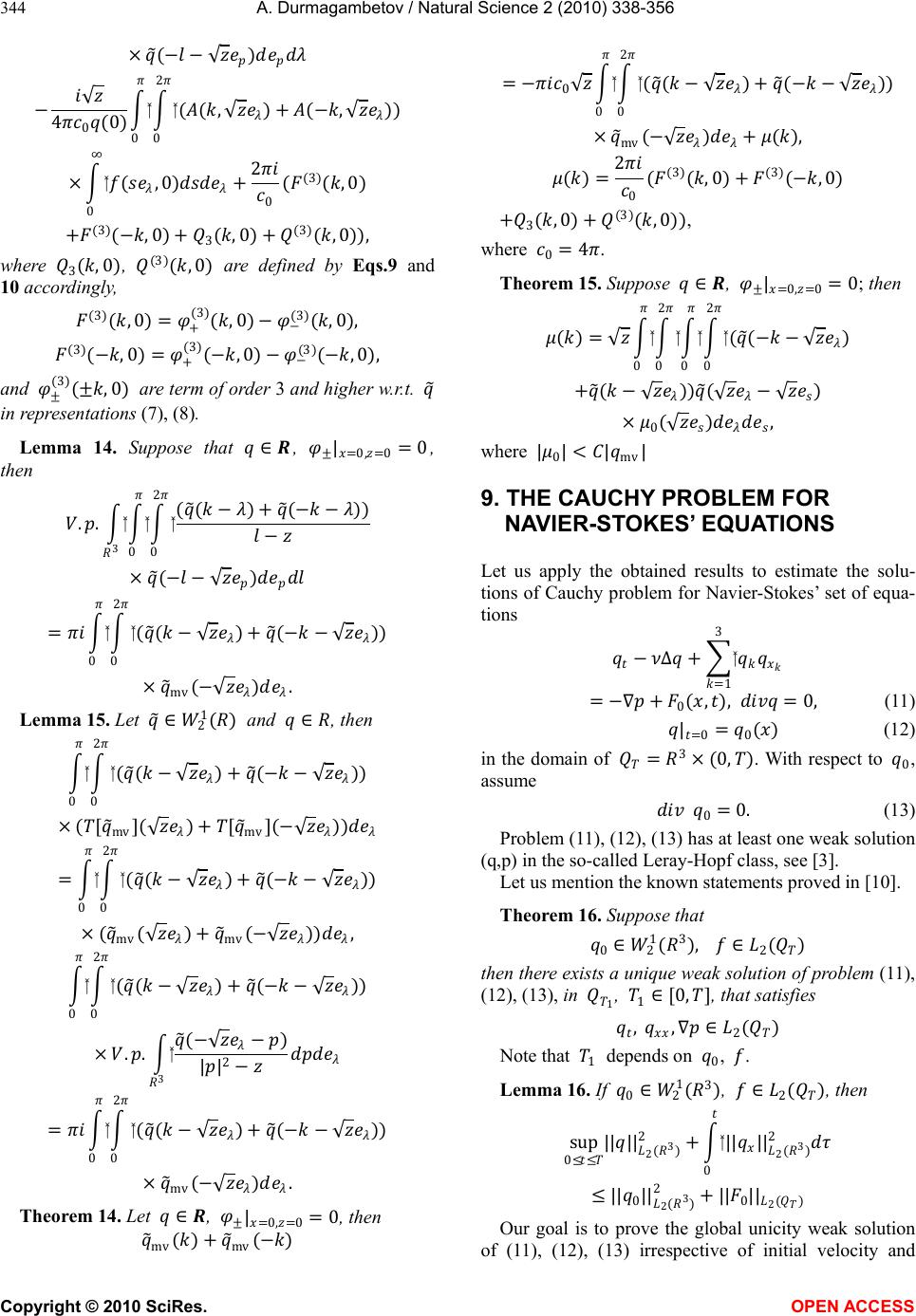 344 A. Durmagambetov / Natural Science 2 (2010) 338-356 Copyright © 2010 SciRes. OPEN ACCESS ×() 40(0) 0 2 0 ((,) + (,)) × 0(, 0)+2 0 ((3) (, 0) +(3) (,0)+3(, 0)+(3 )(, 0)), where 3(, 0), (3 )(, 0) are defined by Eqs.9 and 10 accordingly, (3) (, 0)=+ (3)(, 0) (3)(, 0), (3) (,0)=+ (3)(, 0) (3)(, 0), and ± (3)(±, 0) are term of order 3 and higher w.r.t. in representations (7), (8). Lemma 14. Suppose that , ±|=0,=0= 0, then .. 3 0 2 0 (()+ ()) ×() = 0 2 0 (() + ()) ×mv (). Lemma 15. Let 2 1() and , then 0 2 0 (() + ()) × ([mv ]() + [mv ]()) = 0 2 0 (() + ()) × (mv () + mv ()), 0 2 0 (() + ()) ×.. 3() ||2 = 0 2 0 (() + ()) ×mv (). Theorem 14. Let , ±|=0,=0 =0, then mv () + mv () =0 0 2 0 (() + ()) ×mv ()+(), () =2 0 ((3) (, 0)+(3)(, 0) +3(, 0)+( 3)(, 0)), where 0=4. Theorem 15. Suppose , ±|=0,=0= 0; then () = 0 2 0 0 2 0 (() +())() ×0(), where |0|< |mv | 9. THE CAUCHY PROBLEM FOR NAVIER-STOKES’ EQUATIONS Let us apply the obtained results to estimate the solu- tions of Cauchy problem for Navier-Stokes’ set of equa- tions + 3 =1 =+0(,), = 0, ( 11) |=0=0() (12) in the domain of =3×(0, ). With respect to 0, assume 0= 0. (13) Problem (11), (12), (13) has at least one weak solution (q,p) in the so-called Leray-Hopf class, see [3]. Let us mention the known statements proved in [10]. Theorem 16. Suppose that 02 1(3), 2() then there exists a unique weak solution of problem (11), (12), (13), in 1, 1[0, ], that satisfies , ,2() Note that 1 depends on 0, . Lemma 16. If 02 1(3), 2(), then sup 0||||2(3) 2+ 0 ||||2(3) 2 ||0||2(3) 2+ ||0||2() Our goal is to prove the global unicity weak solution of (11), (12), (13) irrespective of initial velocity and 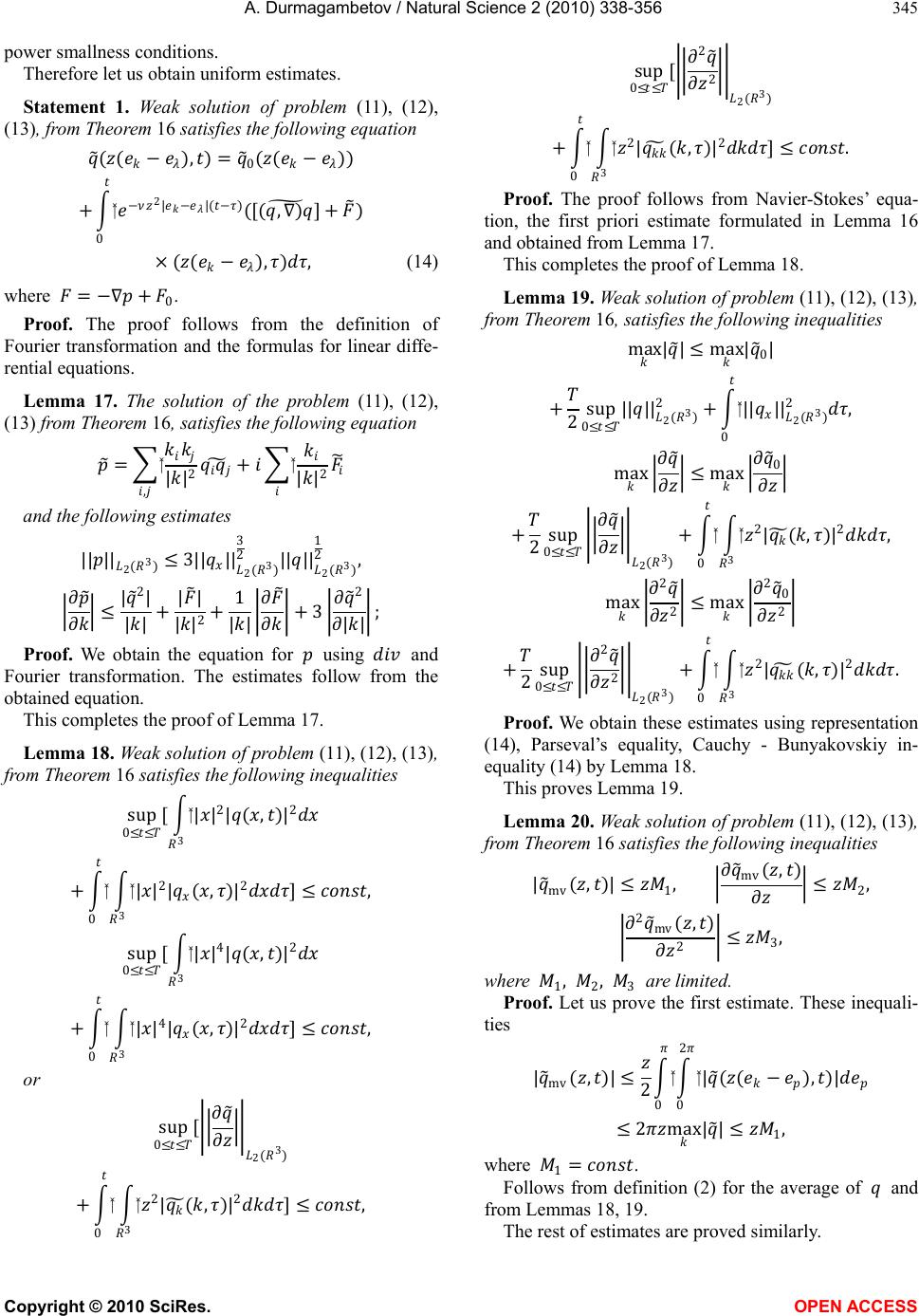 A. Durmagambetov / Natural Science 2 (2010) 338-356 345 Copyright © 2010 SciRes. OPEN ACCESS power smallness conditions. Therefore let us obtain uniform estimates. Statement 1. Weak solution of problem (11), (12), (13), from Theorem 16 satisfies the following equation ((), ) =0(()) + 02||()([(,)] +) × ((), ), (14 ) where =+0. Proof. The proof follows from the definition of Fourier transformation and the formulas for linear diffe- rential equations. Lemma 17. The solution of the problem (11), (12), (13) from Theorem 16, satisfies the following equation = , ||2 + ||2 and the following estimates ||||2(3)3||||2(3) 3 2||||2(3) 1 2, |2| ||+|| ||2+1 || +3 2 ||; Proof. We obtain the equation for using and Fourier transformation. The estimates follow from the obtained equation. This completes the proof of Lemma 17. Lemma 18. Weak solution of problem (11), (12), (13), from Theorem 16 satisfies the following inequalities sup 0[ 3 ||2|(,)|2 + 0 3 ||2|(,)|2], sup 0[ 3 ||4|(,)|2 + 0 3 ||4|(,)|2], or sup 0[ 2(3) + 0 32| (,)|2], sup 0[2 22(3) + 0 32| (,)|2]. Proof. The proof follows from Navier-Stokes’ equa- tion, the first priori estimate formulated in Lemma 16 and obtained from Lemma 17. This completes the proof of Lemma 18. Lemma 19. Weak solution of problem (11), (12), (13), from Theorem 16, satisfies the following inequalities max ||max |0| + 2sup 0||||2(3) 2+ 0 ||||2(3) 2, max max 0 + 2sup 0 2(3) + 0 32| (,)|2, max 2 2max 20 2 + 2sup 02 22(3) + 0 32| (,)|2. Proof. We obtain these estimates using representation (14), Parseval’s equality, Cauchy - Bunyakovskiy in- equality (14) by Lemma 18. This proves Lemma 19. Lemma 20. Weak solution of problem (11), (12), (13), from Theorem 16 satisfies the following inequalities |mv (,)|1,mv (,) 2, 2mv (,) 23, where 1,2,3 are limited. Proof. Let us prove the first estimate. These inequali- ties |mv (,)| 2 0 2 0 |((), )| 2max ||1, where 1=. Follows from definition (2) for the average of and from Lemmas 18, 19. The rest of estimates are proved similarly. 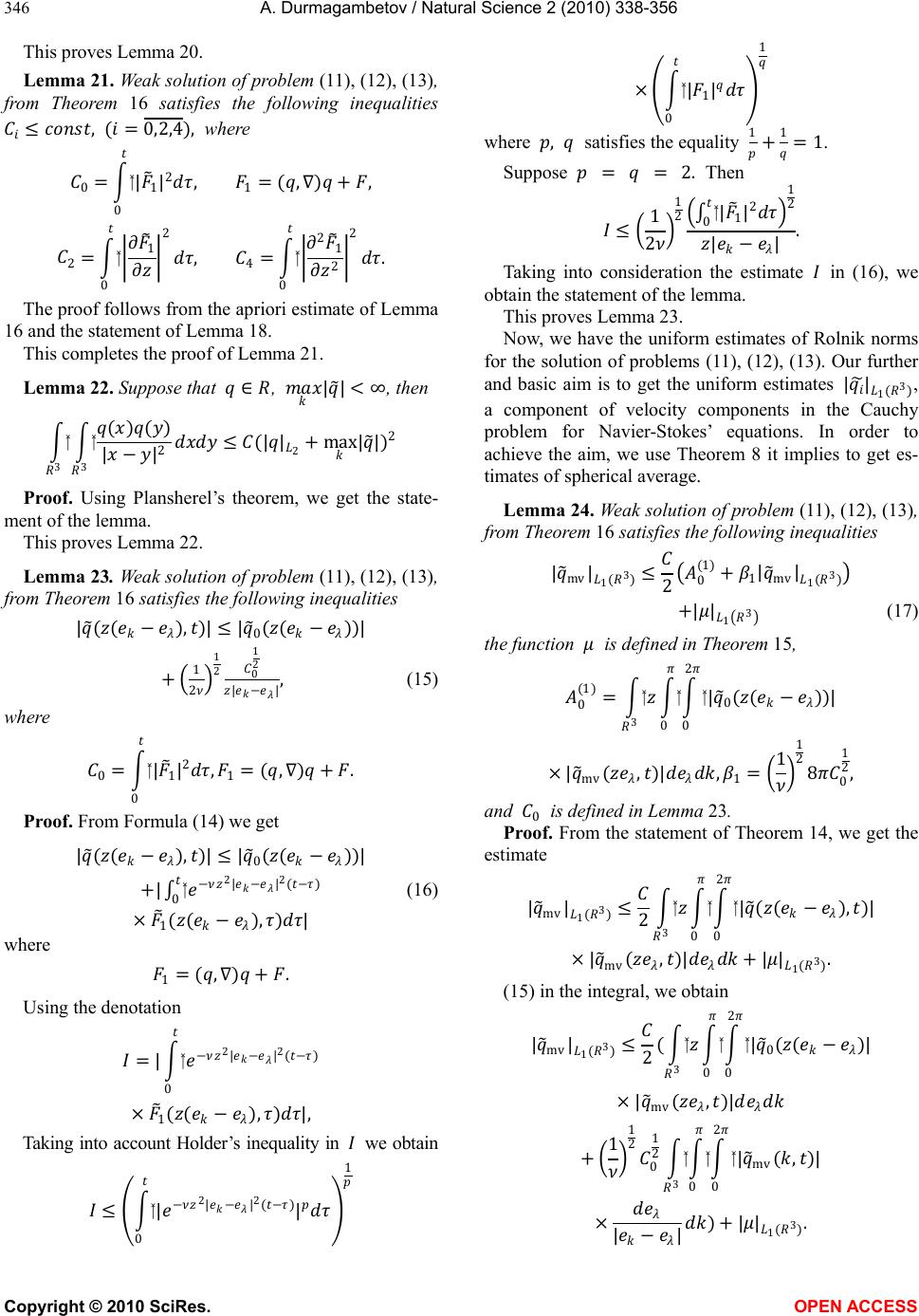 346 A. Durmagambetov / Natural Science 2 (2010) 338-356 Copyright © 2010 SciRes. OPEN ACCESS This proves Lemma 20. Lemma 21. Weak solution of problem (11), (12), (13), from Theorem 16 satisfies the following inequalities , (= 0,2,4), where 0= 0 |1|2,1= (,)+, 2= 01 2,4= 021 22. The proof follows from the apriori estimate of Lemma 16 and the statement of Lemma 18. This completes the proof of Lemma 21. Lemma 22. Suppose that , ||< , then 3 3()() ||2(||2+ max ||)2 Proof. Using Plansherel’s theorem, we get the state- ment of the lemma. This proves Lemma 22. Lemma 23. Weak solution of problem (11), (12), (13), from Theorem 16 satisfies the following inequalities |((), )| |0(())| +1 21 20 1 2 ||, (1 5) where 0= 0 |1|2,1= (,)+. Proof. From Formula (14) we get |((), )| |0(())| +| 02||2() (16) ×1((), )| where 1= (,)+. Using the denotation =| 02||2() ×1((), )|, Taking into account Holder’s inequality in we obtain 0 |2||2()| 1 × 0 |1| 1 where , satisfies the equality 1 +1 = 1. Suppose = = 2. Then 1 21 2 0|1|21 2 ||. Taking into consideration the estimate in (16), we obtain the statement of the lemma. This proves Lemma 23. Now, we have the uniform estimates of Rolnik norms for the solution of problems (11), (12), (13). Our further and basic aim is to get the uniform estimates | |1(3), a component of velocity components in the Cauchy problem for Navier-Stokes’ equations. In order to achieve the aim, we use Theorem 8 it implies to get es- timates of spherical average. Lemma 24. Weak solution of problem (11), (12), (13), from Theorem 16 satisfies the following inequalities |mv |1(3) 20 (1) +1|mv |1(3) +||13 (17) the function is defined in Theorem 15, 0 (1) = 3 0 2 0 |0(())| × |mv (,)|,1=1 1 280 1 2, and 0 is defined in Lemma 23. Proof. From the statement of Theorem 14, we get the estimate |mv |1(3) 2 3 0 2 0 |((), )| × |mv (,)|+ ||1(3). (15) in the integral, we obtain |mv |1(3) 2( 3 0 2 0 |0(()| × |mv (,)| +1 1 20 1 2 3 0 2 0 |mv (,)| × ||)+ ||1(3). 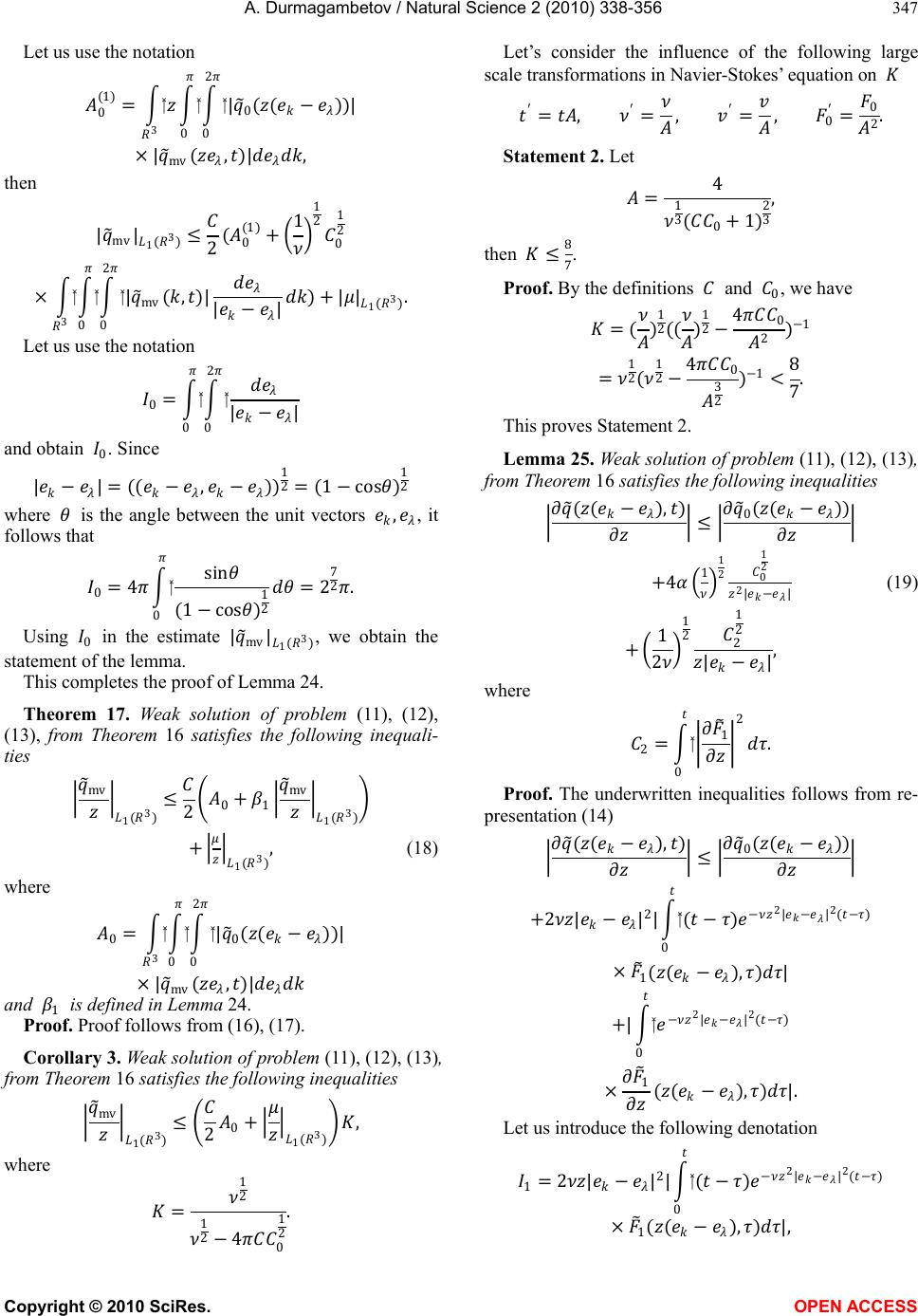 A. Durmagambetov / Natural Science 2 (2010) 338-356 347 Copyright © 2010 SciRes. OPEN ACCESS Let us use the notation 0 (1) = 3 0 2 0 |0(())| × |mv (,)|, then |mv |1(3) 2(0 (1) +1 1 20 1 2 × 3 0 2 0 |mv (,)| ||)+ ||1(3). Let us use the notation 0= 0 2 0 || and obtain 0. Since || = ((,)) 1 2=(1 cos) 1 2 where is the angle between the unit vectors ,, it follows that 0= 4 0 sin (1 cos) 1 2= 2 7 2. Using 0 in the estimate |mv |1(3), we obtain the statement of the lemma. This completes the proof of Lemma 24. Theorem 17. Weak solution of problem (11), (12), (13), from Theorem 16 satisfies the following inequali- ties mv 1(3) 20+1mv 1(3) + 1(3), (18) where 0= 3 0 2 0 |0(())| × |mv (,)| and 1 is defined in Lemma 24. Proof. Proof follows from (16), (17). Corollary 3. Weak solution of problem (11), (12), (13), from Theorem 16 satisfies the following inequalities mv 1(3) 20+ 1(3), where =1 2 1 240 1 2 . Let’s consider the influence of the following large scale transformations in Navier-Stokes’ equation on =,= ,= ,0 =0 2. Statement 2. Let =4 1 3(0+ 1) 2 3 , then 8 7. Proof. By the definitions and 0, we have =( ) 1 2(( ) 1 240 2)1 =1 2(1 240 3 2 )1<8 7. This proves Statement 2. Lemma 25. Weak solution of problem (11), (12), (13), from Theorem 16 satisfies the following inequalities ((), ) 0(()) +41 1 20 1 2 2|| (19) +1 21 22 1 2 ||, where 2= 01 2. Proof. The underwritten inequalities follows from re- presentation (14) ((), ) 0(()) +2||2| 0 ()2||2() ×1((), )| +| 02||2() ×1 ((), )|. Let us introduce the following denotation 1= 2||2| 0 ()2||2() ×1((), )|, 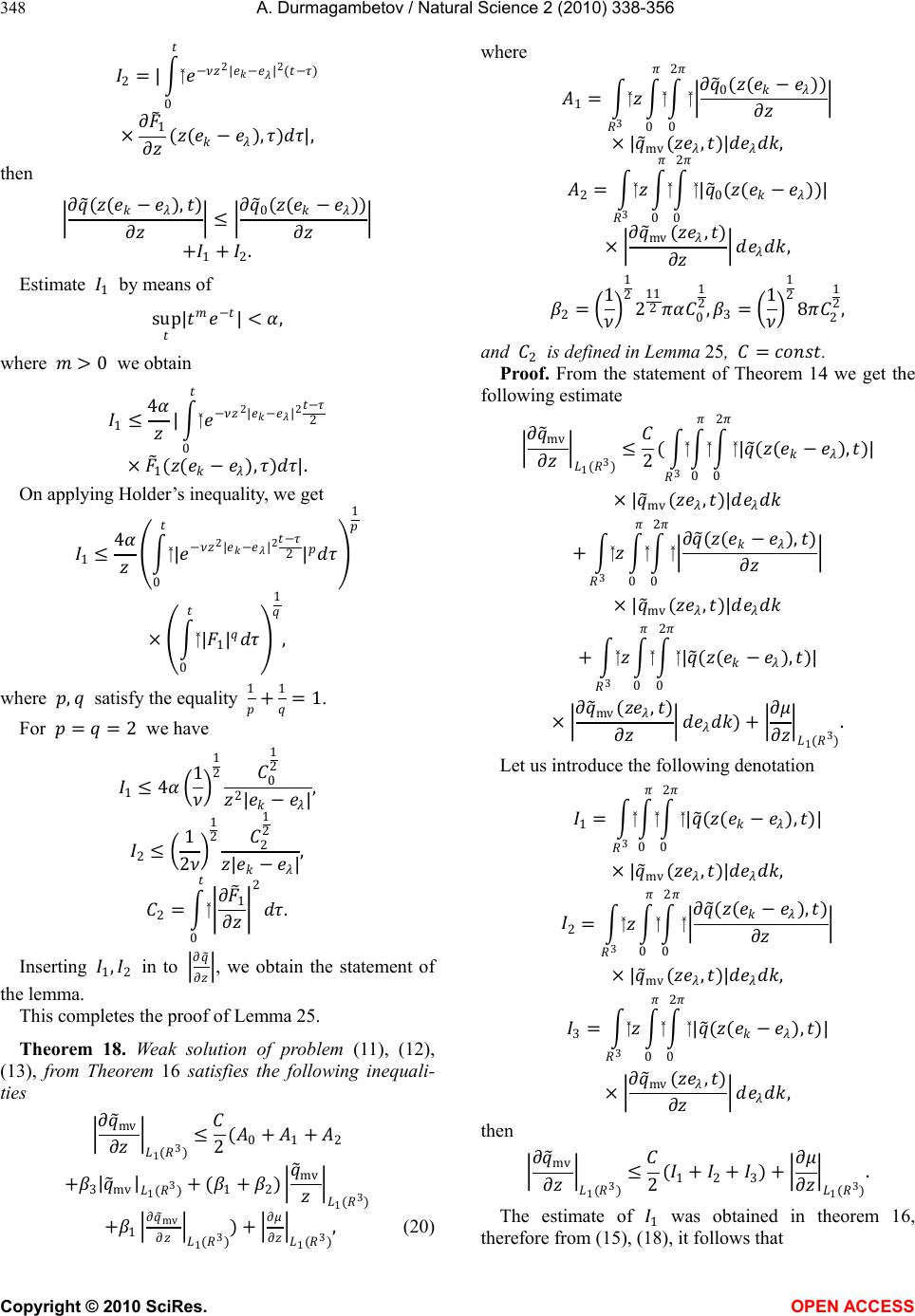 348 A. Durmagambetov / Natural Science 2 (2010) 338-356 Copyright © 2010 SciRes. OPEN ACCESS 2=| 02||2() ×1 ((), )|, then ((), ) 0(()) +1+2. Estimate 1 by means of sup || <, where > 0 we obtain 14 | 02||2 2 ×1((), )|. On applying Holder’s inequality, we get 14 0 |2||2 2| 1 × 0 |1| 1 , where , satisfy the equality 1 +1 =1. For == 2 we have 141 1 20 1 2 2||, 21 21 22 1 2 ||, 2= 01 2. Inserting 1,2 in to , we obtain the statement of the lemma. This completes the proof of Lemma 25. Theorem 18. Weak solution of problem (11), (12), (13), from Theorem 16 satisfies the following inequali- ties mv 1(3) 2(0+1+2 +3|mv |1(3)+ (1+2)mv 1(3) +1mv 1(3)) + 1(3), (20) where 1= 3 0 2 00(()) × |mv (,)|, 2= 3 0 2 0 |0(())| ×mv (,) , 2=1 1 22 11 20 1 2,3=1 1 282 1 2, and 2 is defined in Lemma 25, =. Proof. From the statement of Theorem 14 we get the following estimate mv 1(3) 2( 3 0 2 0 |((), )| × |mv (,)| + 3 0 2 0((), ) × |mv (,)| + 3 0 2 0 |((), )| ×mv (,) ) + 1(3) . Let us introduce the following denotation 1= 3 0 2 0 |((), )| × |mv (,)|, 2= 3 0 2 0((), ) × |mv (,)|, 3= 3 0 2 0 |((), )| ×mv (,) , then mv 1(3) 2(1+2+3) + 1(3) . The estimate of 1 was obtained in theorem 16, therefore from (15), (18), it follows that 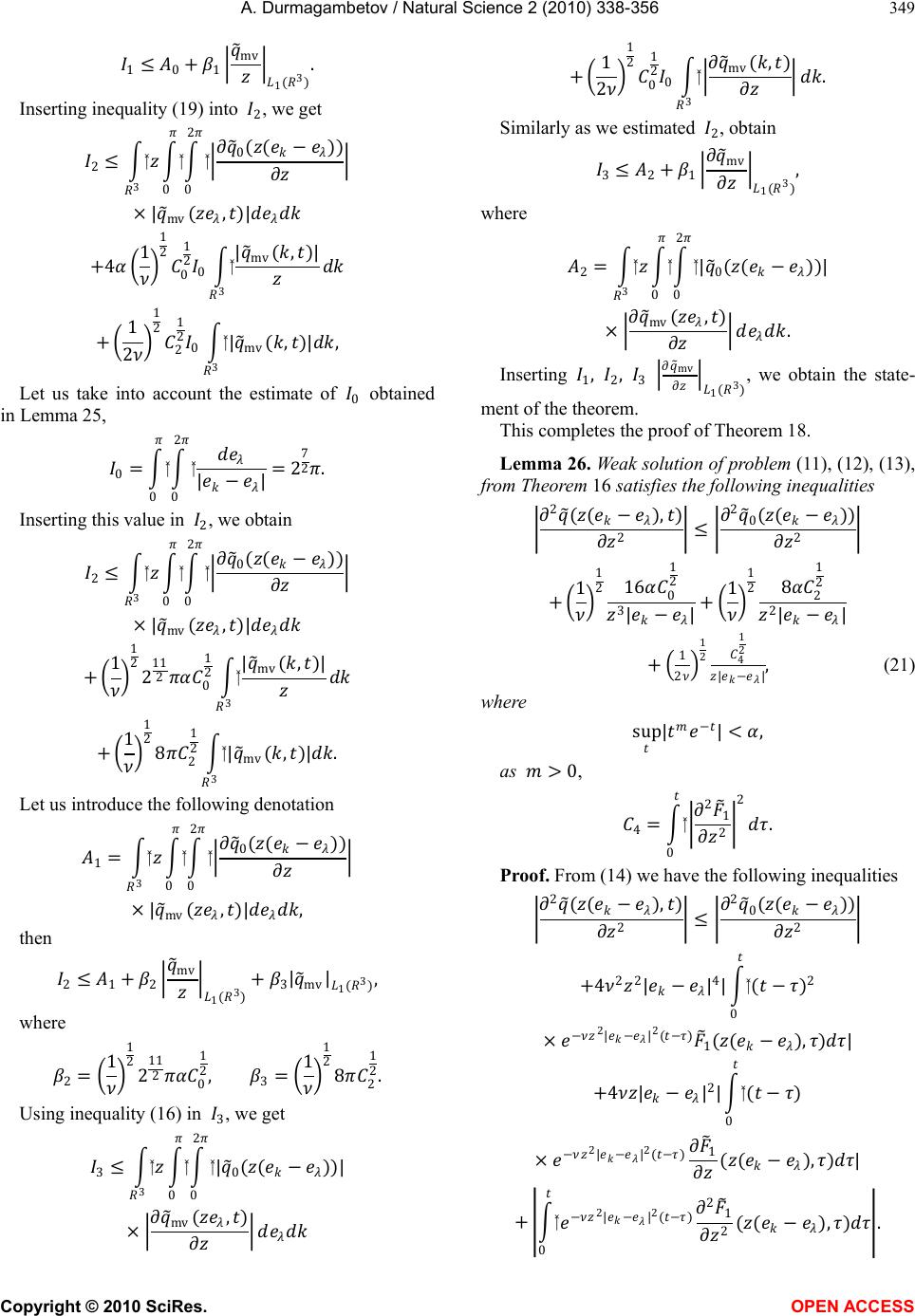 A. Durmagambetov / Natural Science 2 (2010) 338-356 349 Copyright © 2010 SciRes. OPEN ACCESS 10+1mv 1(3) . Inserting inequality (19) into 2, we get 2 3 0 2 00(()) × |mv (,)| +41 1 20 1 20 3 |mv (,)| +1 21 22 1 20 3 |mv (,)|, Let us take into account the estimate of 0 obtained in Lemma 25, 0= 0 2 0 ||= 2 7 2. Inserting this value in 2, we obtain 2 3 0 2 00(()) × |mv (,)| +1 1 22 11 20 1 2 3 |mv (,)| +1 1 282 1 2 3 |mv (,)|. Let us introduce the following denotation 1= 3 0 2 00(()) × |mv (,)|, then 21+2mv 1(3) +3|mv |1(3), where 2=1 1 22 11 20 1 2,3=1 1 282 1 2. Using inequality (16) in 3, we get 3 3 0 2 0 |0(())| ×mv (,) +1 21 20 1 20 3mv (,) . Similarly as we estimated 2, obtain 32+1mv 1(3) , where 2= 3 0 2 0 |0(())| ×mv (,) . Inserting 1,2,3 mv 1(3), we obtain the state- ment of the theorem. This completes the proof of Theorem 18. Lemma 26. Weak solution of problem (11), (12), (13), from Theorem 16 satisfies the following inequalities 2((), ) 220(()) 2 +1 1 2160 1 2 3||+1 1 282 1 2 2|| +1 21 24 1 2 ||, ( 21) where sup || <, as > 0, 4= 021 22. Proof. From (14) we have the following inequalities 2((), ) 220(()) 2 +422||4| 0 ()2 ×2||2()1((), )| +4||2| 0 () ×2||2()1 ((), )| + 02||2()21 2((), ). 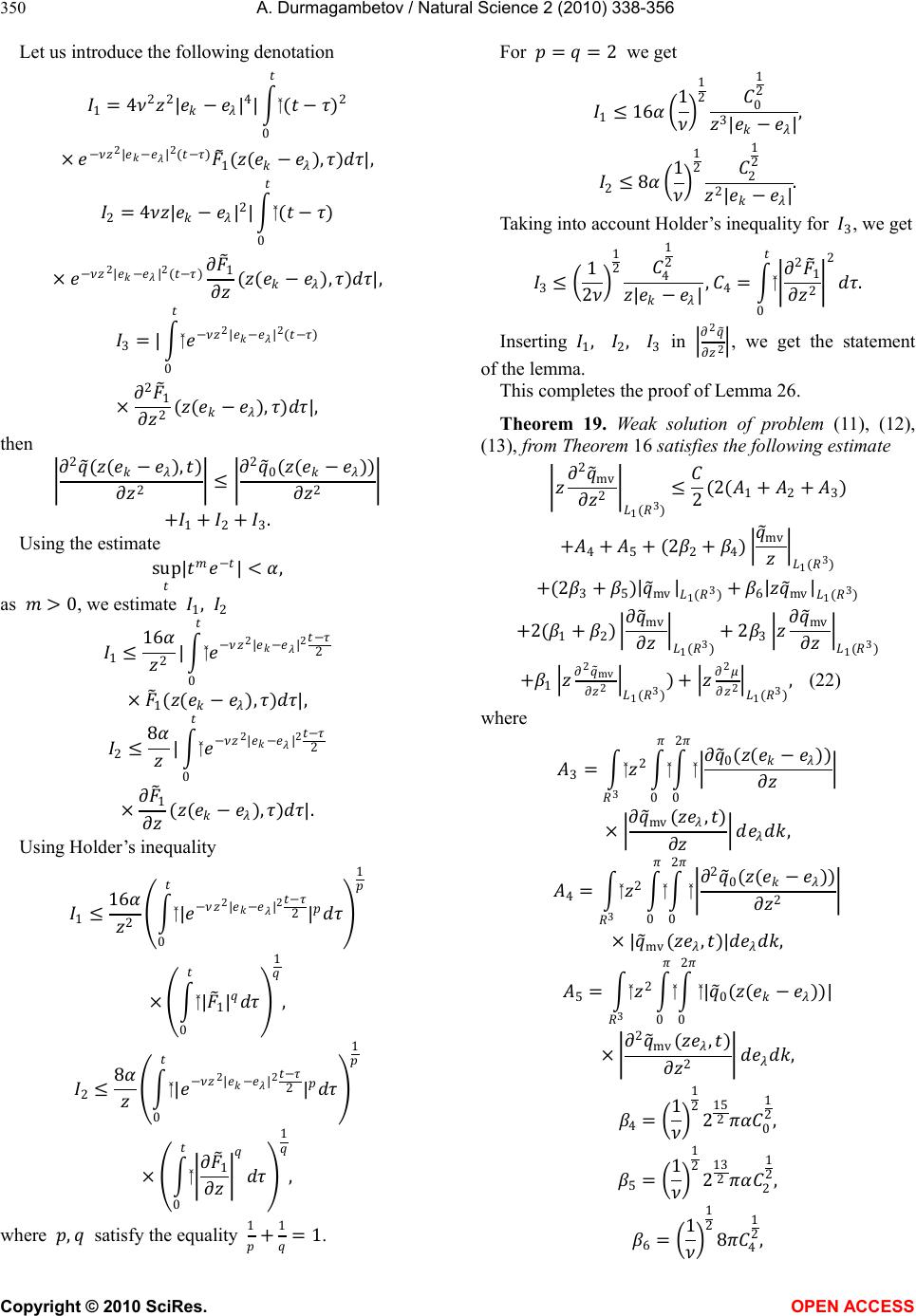 350 A. Durmagambetov / Natural Science 2 (2010) 338-356 Copyright © 2010 SciRes. OPEN ACCESS Let us introduce the following denotation 1= 422||4| 0 ()2 ×2||2()1((), )|, 2= 4||2| 0 () ×2||2()1 ((), )|, 3=| 02||2() ×21 2((), )| , then 2((), ) 220(()) 2 +1+2+3. Using the estimate sup || <, as > 0, we estimate 1,2 116 2| 02||2 2 ×1((), )|, 28 | 02||2 2 ×1 ((), )|. Using Holder’s inequality 116 2 0 |2||2 2| 1 × 0 |1| 1 , 28 0 |2||2 2| 1 × 01 1 , where , satisfy the equality 1 +1 =1. For == 2 we get 1161 1 20 1 2 3||, 281 1 22 1 2 2||. Taking into account Holder’s inequality for 3, we get 31 21 24 1 2 ||,4= 021 22. Inserting 1, 2, 3 in 2 2, we get the statement of the lemma. This completes the proof of Lemma 26. Theorem 19. Weak solution of problem (11), (12), (13), from Theorem 16 satisfies the following estimate 2mv 21(3) 2(2(1+2+3) +4+5+ (22+4)mv 1(3) +(23+5)|mv |1(3)+6|mv |1(3) +2(1+2)mv 1(3) + 23mv 1(3) +12mv 21(3)) + 2 21(3), (22) where 3= 32 0 2 00(()) ×mv (,) , 4= 32 0 2 020(()) 2 × |mv (,)|, 5= 32 0 2 0 |0(())| ×2mv (,) 2, 4=1 1 22 15 20 1 2, 5=1 1 22 13 22 1 2, 6=1 1 284 1 2, 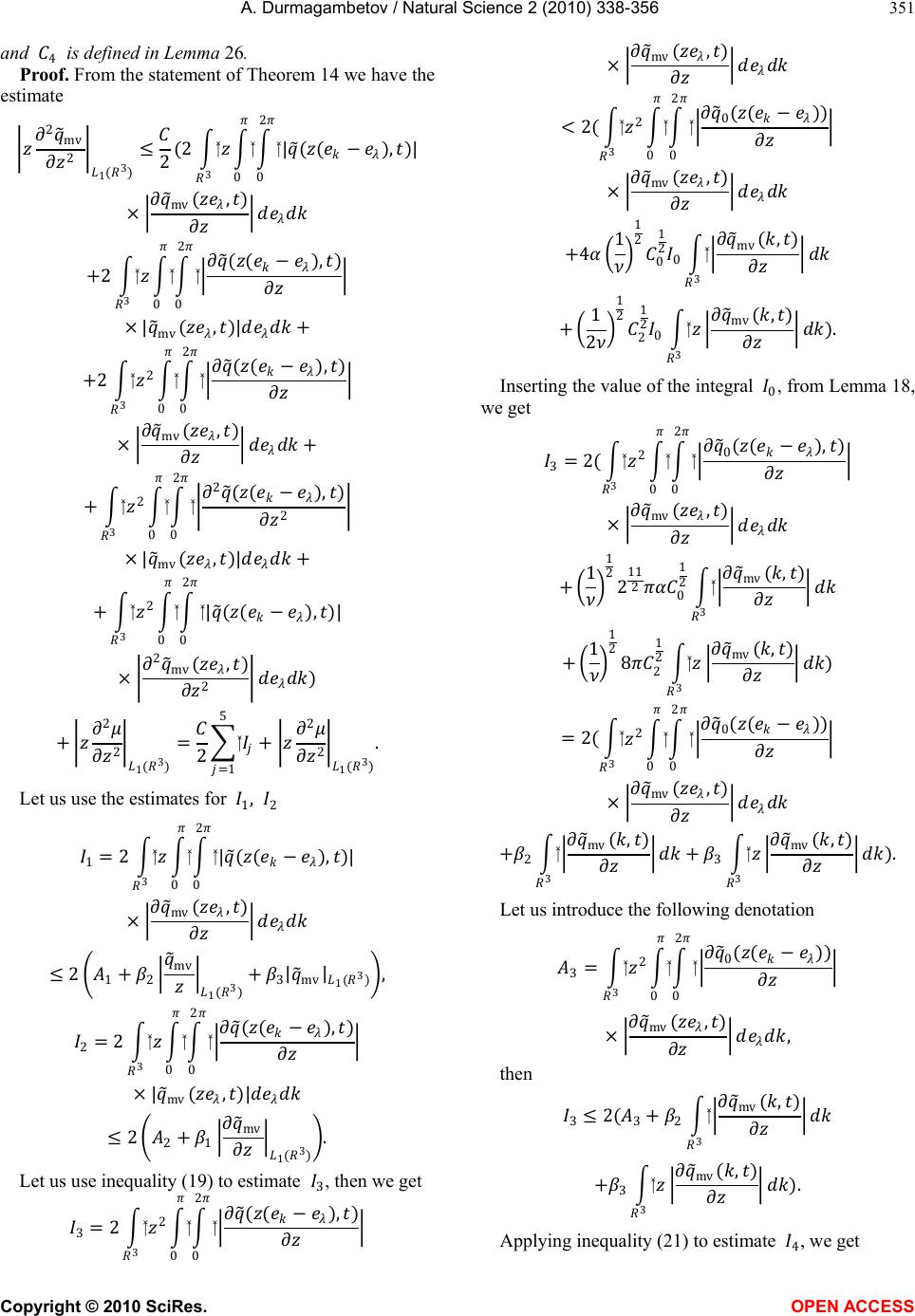 A. Durmagambetov / Natural Science 2 (2010) 338-356 351 Copyright © 2010 SciRes. OPEN ACCESS and 4 is defined in Lemma 26. Proof. From the statement of Theorem 14 we have the estimate 2mv 21(3) 2(2 3 0 2 0 |((), )| ×mv (,) +2 3 0 2 0((), ) × |mv (,)|+ +2 32 0 2 0((), ) ×mv (,) + + 32 0 2 02((), ) 2 × |mv (,)|+ + 32 0 2 0 |((), )| ×2mv (,) 2) +2 21(3) = 2 5 =1 +2 21(3) . Let us use the estimates for 1,2 1= 2 3 0 2 0 |((), )| ×mv (,) 21+2mv 1(3) +3|mv |1(3), 2= 2 3 0 2 0((), ) × |mv (,)| 22+1mv 1(3). Let us use inequality (19) to estimate 3, then we get 3= 2 32 0 2 0((), ) ×mv (,) <2( 32 0 2 00(()) ×mv (,) +41 1 20 1 20 3mv (,) +1 21 22 1 20 3mv (,) ). Inserting the value of the integral 0, from Lemma 18, we get 3=2( 32 0 2 00((), ) ×mv (,) +1 1 22 11 20 1 2 3mv (,) +1 1 282 1 2 3mv (,) ) =2( 32 0 2 00(()) ×mv (,) +2 3mv (,) +3 3mv (,) ). Let us introduce the following denotation 3= 32 0 2 00(()) ×mv (,) , then 32(3+2 3mv (,) +3 3mv (,) ). Applying inequality (21) to estimate 4, we get 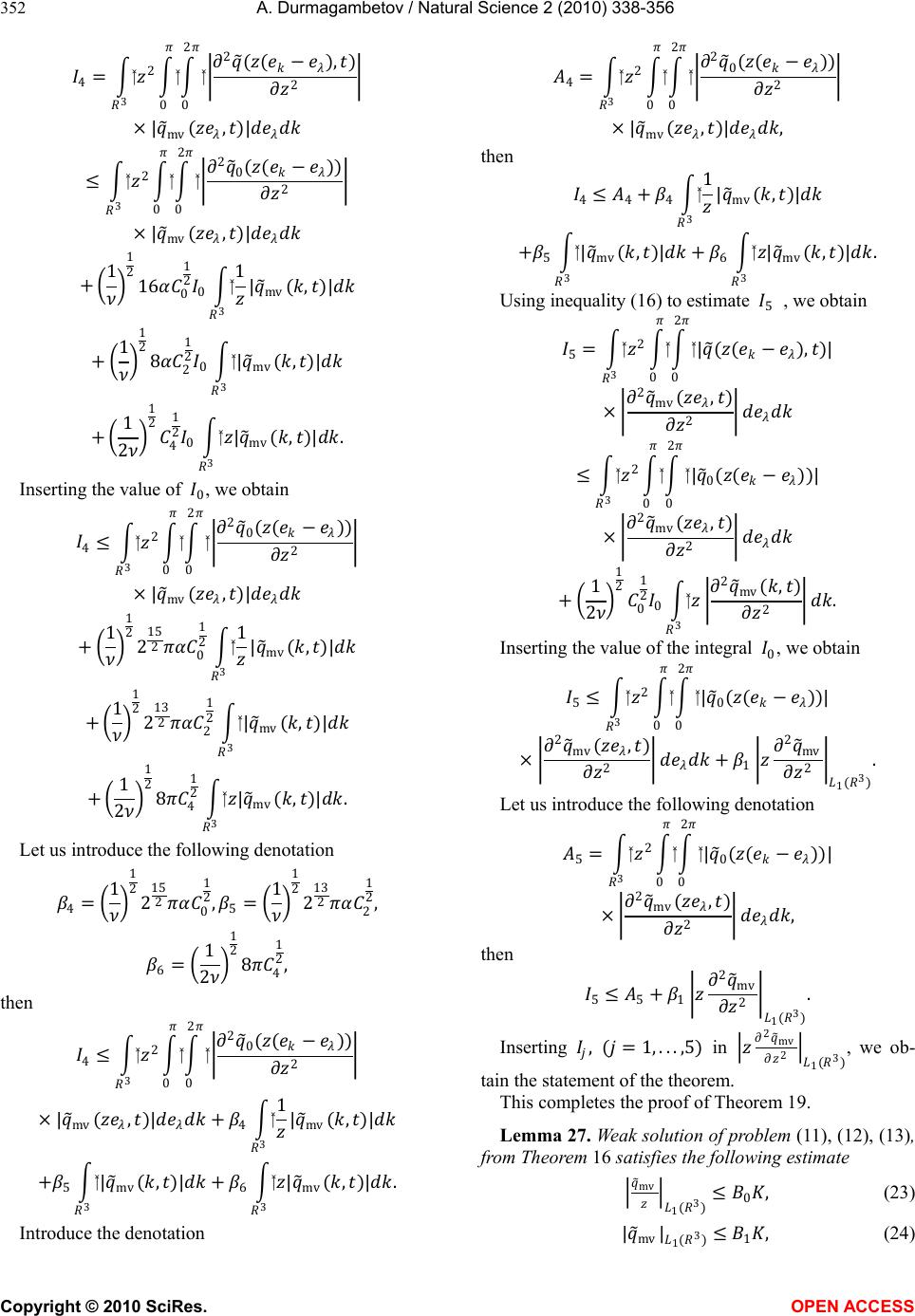 352 A. Durmagambetov / Natural Science 2 (2010) 338-356 Copyright © 2010 SciRes. OPEN ACCESS 4= 32 0 2 02((), ) 2 × |mv (,)| 32 0 2 020(()) 2 × |mv (,)| +1 1 2160 1 20 3 1 |mv (,)| +1 1 282 1 20 3 |mv (,)| +1 21 24 1 20 3|mv (,)|. Inserting the value of 0, we obtain 4 32 0 2 020(()) 2 × |mv (,)| +1 1 22 15 20 1 2 3 1 |mv (,)| +1 1 22 13 22 1 2 3 |mv (,)| +1 21 284 1 2 3|mv (,)|. Let us introduce the following denotation 4=1 1 22 15 20 1 2,5=1 1 22 13 22 1 2, 6=1 21 284 1 2, then 4 32 0 2 020(()) 2 × |mv (,)|+4 3 1 |mv (,)| +5 3 |mv (,)|+6 3|mv (,)|. Introduce the denotation 4= 32 0 2 020(()) 2 × |mv (,)|, then 44+4 3 1 |mv (,)| +5 3 |mv (,)|+6 3|mv (,)|. Using inequality (16) to estimate 5 , we obtain 5= 32 0 2 0 |((), )| ×2mv (,) 2 32 0 2 0 |0(())| ×2mv (,) 2 +1 21 20 1 20 32mv (,) 2. Inserting the value of the integral 0, we obtain 5 32 0 2 0 |0(())| ×2mv (,) 2+12mv 21(3) . Let us introduce the following denotation 5= 32 0 2 0 |0(())| ×2mv (,) 2, then 55+12mv 21(3) . Inserting ,(=1, . . . ,5) in 2mv 21(3), we ob- tain the statement of the theorem. This completes the proof of Theorem 19. Lemma 27. Weak solution of problem (11), (12), (13), from Theorem 16 satisfies the following estimate mv 1(3)0, (23) |mv |1(3)1, (24)  A. Durmagambetov / Natural Science 2 (2010) 338-356 353 Copyright © 2010 SciRes. OPEN ACCESS |mv |1(3)2, (25) where =1 2 1 240 1 2 ,0= 20+ 1(3) , 1= 20 (1) + ||1(3), (26) 2= 20 (2) + ||1(3), 0 (2) = 3 0 2 02|0(())| × |mv (,)|. Proof. From inequality (15) and estimate (17), we make the sequence of estimates |mv |1(3) 20 (+1) +1|mv |1(3) +||1(3), where 0 (+1) = 3 0 2 0+1|0(())| × |mv (,)|. 1=1 1 280 1 2, and is an exponent of . From this recurrence for- mula, as = 0,=1, we get estimates (17) and (18) accordingly. For = 1 we have |mv |1(3) 20 (2) +1|mv |1(3) +||1(3). Considering estimates (17), (18) and the last estimate, we obtain the statement of the lemma. This proves Lemma 27. Lemma 28. Weak solution of problem (11), (12), (13), from Theorem 16 satisfies the following estimates mv 1(3)02+1, (27) mv 1(3)22+3, (28) where 0= 23 (0)1+ (1 (0) +2 (0))0, 1= 2(0+1+2)+ 1(3) , 2= 23 (0)2+ (1 (0) +2 (0))1, 3= 20 (1) +1 (1) +2 (1)+ 1(3) , 1 (1) = 32 0 2 00(()) × |mv (,)|, 2 (1) = 32 0 2 0 |0(())| ×mv (,) , 1 (0) =80 1 2 1 2 ,2 (0) =2 11 20 1 2 1 2 , 3 (0) =82 1 2 1 2 , Proof. From inequality (19) and estimate (20), let us make the sequence of estimates mv 1(3) 2(0 ()+1 ()+2 () +3|mv |1(3)+ (1+2)mv 11(3) +1mv 1(3) ) + 1(3) , where 0 ()= 3 0 2 0|0(())| × |mv (,)|, 1 ()= 3+1 0 2 00(()) × |mv (,)|, 2 ()= 3+1 0 2 0 |0(())| ×mv (,) , and is an exponent of . From this recurrence for- mula, we get estimate (17) and (18) for = 0,= 1, accordingly. And mv 1(3) 2(0 (1) +1 (1) +2 (1) +3|mv |1(3)+ (1+2)|mv |1(3) 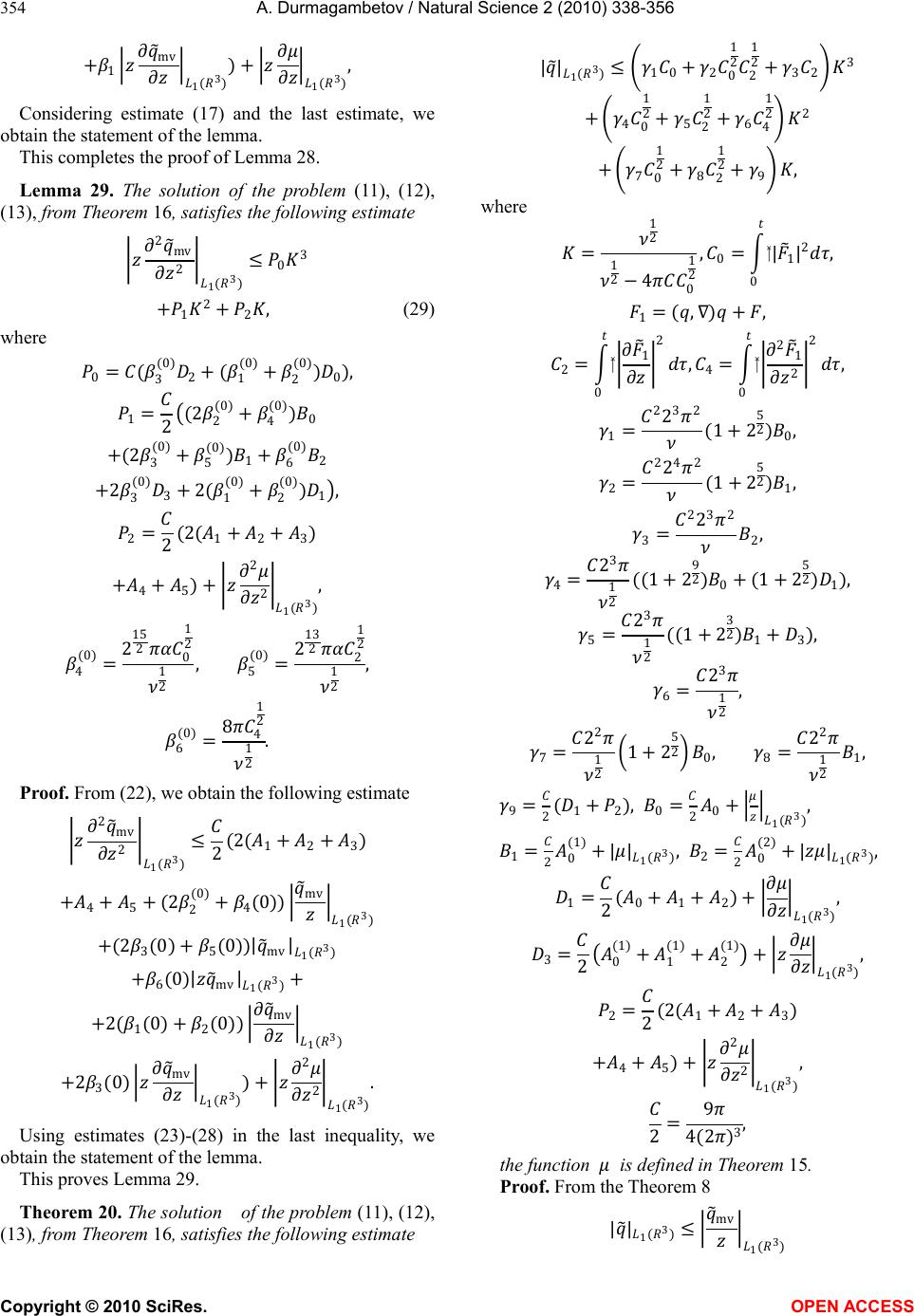 354 A. Durmagambetov / Natural Science 2 (2010) 338-356 Copyright © 2010 SciRes. OPEN ACCESS +1mv 1(3) ) + 1(3) , Considering estimate (17) and the last estimate, we obtain the statement of the lemma. This completes the proof of Lemma 28. Lemma 29. The solution of the problem (11), (12), (13), from Theorem 16, satisfies the following estimate 2mv 21(3)03 +12+2, (29) where 0=(3 (0)2+ (1 (0) +2 (0))0), 1= 2(22 (0) +4 (0))0 +(23 (0) +5 (0))1+6 (0)2 +23 (0)3+ 2(1 (0) +2 (0))1, 2= 2(2(1+2+3) +4+5) + 2 21(3) , 4 (0) =2 15 20 1 2 1 2 ,5 (0) =2 13 22 1 2 1 2 , 6 (0) =84 1 2 1 2 . Proof. From (22), we obtain the following estimate 2mv 21(3) 2(2(1+2+3) +4+5+ (22 (0) +4(0)) mv 1(3) +(23(0) + 5(0))|mv |1(3) +6(0)|mv |1(3)+ +2(1(0) + 2(0)) mv 1(3) +23(0) mv 1(3) ) + 2 21(3) . Using estimates (23)-(28) in the last inequality, we obtain the statement of the lemma. This proves Lemma 29. Theorem 20. The solution of the problem (11), (12), (13), from Theorem 16, satisfies the following estimate ||1(3)10+20 1 22 1 2+323 +40 1 2+52 1 2+64 1 22 +70 1 2+82 1 2+9, where =1 2 1 240 1 2 ,0= 0 |1|2, 1= (,)+, 2= 01 2,4= 021 22, 1=2232 (1 + 2 5 2)0, 2=2242 (1 + 2 5 2)1, 3=2232 2, 4=23 1 2 ((1 + 2 9 2)0+ (1+ 2 5 2)1), 5=23 1 2 ((1 + 2 3 2)1+3), 6=23 1 2 , 7=22 1 21 + 2 5 20,8=22 1 21, 9= 2(1+2), 0= 20+ 1(3), 1= 20 (1) + ||1(3), 2= 20 (2) + ||1(3), 1= 2(0+1+2)+ 1(3) , 3= 20 (1) +1 (1) +2 (1)+ 1(3) , 2= 2(2(1+2+3) +4+5) + 2 21(3) , 2=9 4(2)3, the function is defined in Theorem 15. Proof. From the Theorem 8 ||1(3)mv 1(3) 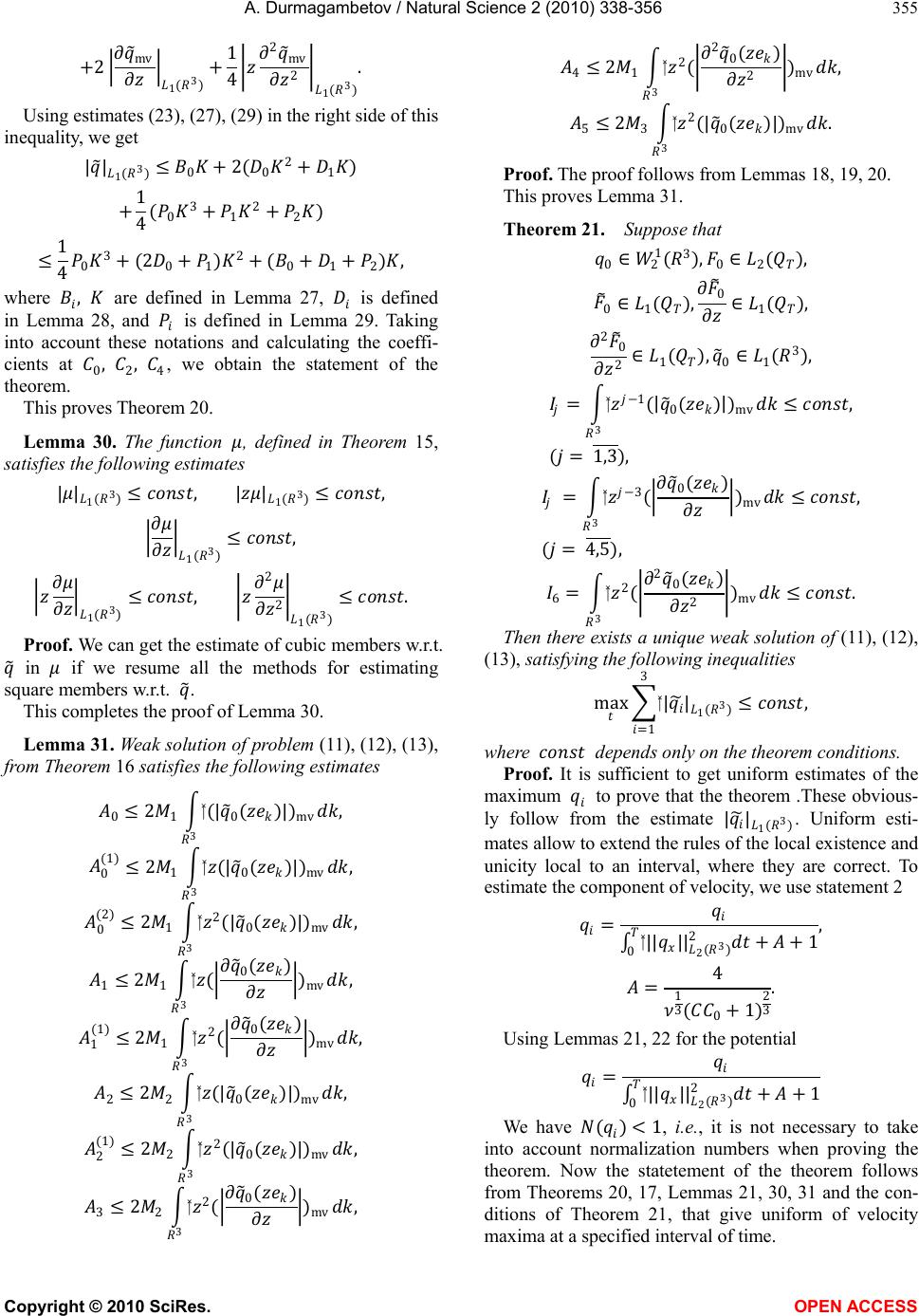 A. Durmagambetov / Natural Science 2 (2010) 338-356 355 Copyright © 2010 SciRes. OPEN ACCESS +2 mv 1(3) +1 42mv 21(3) . Using estimates (23), (27), (29) in the right side of this inequality, we get ||1(3)0+ 2(02+1) +1 4(03+12+2) 1 403+ (20+1)2+ (0+1+2), where , are defined in Lemma 27, is defined in Lemma 28, and is defined in Lemma 29. Taking into account these notations and calculating the coeffi- cients at 0,2,4, we obtain the statement of the theorem. This proves Theorem 20. Lemma 30. The function , defined in Theorem 15, satisfies the following estimates ||1(3),||1(3), 1(3), 1(3),2 21(3). Proof. We can get the estimate of cubic members w.r.t. in if we resume all the methods for estimating square members w.r.t. . This completes the proof of Lemma 30. Lemma 31. Weak solution of problem (11), (12), (13), from Theorem 16 satisfies the following estimates 021 3 (|0()|)mv , 0 (1) 21 3(|0()|)mv , 0 (2) 21 32(|0()|)mv , 121 3(0() )mv , 1 (1) 21 32(0() )mv , 222 3(|0()|)mv , 2 (1) 22 32(|0()|)mv , 322 32(0() )mv , 421 32(20() 2)mv , 523 32(|0()|)mv . Proof. The proof follows from Lemmas 18, 19, 20. This proves Lemma 31. Theorem 21. Suppose that 02 1(3), 02(), 01(), 0 1(), 20 21(), 01(3), = 31(|0()|)mv , (= 1,3), = 33(0() )mv , (= 4,5), 6= 32(20() 2)mv . Then there exists a unique weak solution of (11), (12), (13), satisfying the following inequalities max 3 =1 | |1(3), where depends only on the theorem conditions. Proof. It is sufficient to get uniform estimates of the maximum to prove that the theorem .These obvious- ly follow from the estimate | |1(3). Uniform esti- mates allow to extend the rules of the local existence and unicity local to an interval, where they are correct. To estimate the component of velocity, we use statement 2 = 0||||2(3) 2++ 1, =4 1 3(0+ 1) 2 3 . Using Lemmas 21, 22 for the potential = 0||||2(3) 2++ 1 We have ()<1, i.e., it is not necessary to take into account normalization numbers when proving the theorem. Now the statetement of the theorem follows from Theorems 20, 17, Lemmas 21, 30, 31 and the con- ditions of Theorem 21, that give uniform of velocity maxima at a specified interval of time.  356 A. Durmagambetov / Natural Science 2 (2010) 338-356 Copyright © 2010 SciRes. OPEN ACCESS This comletes the proof of Theorem 21. Note. In the estimate for the condition (0) >1 is used. This conditioncan be obviated if we use smooth and bounded function and make all the estimates for 1=+ such that 1(0)>1 is satisfied. Using the function , we also choose the constant A concordant with the constant from Lemma 3. Theorem 21 proves the global solvability and unicity of the Cauchy problem for Navier-Stokes’ equation. 10. CONCLUSIONS In Introduction we mentioned the authors whose scien- tific researches we consider appropriate to call the pre- history of this work. The list of these authors may be considerably extended if we enumerate all the predeces- sors diachronically or by the significance of their con- tribution into this research. Actually we intended to ob- tain evident results which were directly and indirectly indicated by these authors in their scientific works. We do not concentrate on the solution to the multi- dimen- sional problem of quantum scattering theory although it follows from some certain statements proved in this work. In fact, the problem of over-determination in the multi-dimensional inverse problem of quantum scatter- ing theory is obviated since a potential can be defined by amplitude averaging when the amplitude is a function of three variables. In the classic case of the multi- dimen- sional inverse problem of quantum scattering theory the potential requires restoring with respect to the amplitude that depends on five variables. This obviously leads to the problem of over-determination. Further detalization could have distracted us from the general research line of the work consisting in application of energy and mo- mentum conservation laws in terms of wave functions to the theory of nonlinear equations. This very method we use in solving the problem of the century, the problem of solvability of the Cauchy problem for Navier-Stokes’ equations of viscous incompressible fluid. Let us also note the importance of the fact that the laws of momen- tum and energy conservation in terms of wave functions are conservation laws in the micro-world; but in the clas- sic methods of studying nonlinear equations scientists usually use the priori estimates reflecting the conserva- tion laws of macroscopic quantities. We did not focus attention either on obtaining exact estimates dependent on viscosity, lest the calculations be complicated. How- ever, the pilot analysis shows the possibility of applying these estimates to the problem of limiting viscosity tran- sition tending to zero. REFERENCES [1] Durmagambetov, A.A. and Fazylova, L.S. (1997) Some methods of solving nonlinear equations. Herald of the Karaganda University, Publishers KarGU, Karaganda, 1, 6-17. [2] Durmagambetov, A.A. (1996) Inverse problem of quantum theory of scattering. International Conference on Inverse and III-Posed Problems, Moscow, 57, 27-30. [3] Leray, J. (1934) Sur le mouvement d’un liquide visquex emp- lissant l’espace. Acta Math, 63, 193-248. [4] Novikov, R. G. and Henkin , G.M. (1987) Equation in multidimensional inverse problem of scattering. Success in Mathematics, N3, 93-152. [5] Faddeev, L.D. (1974) Inverse problem of quantum theory of scattering. Modern Problems of Math-Ematicians, VINITI, 3, 93-180. [6] Ramm, A.G. (1992) Multidimensional inverse scattering problems. Pitman Monographs and Surveys in Pure and Applied Mathematics, Longman Scientific Technical, Haplow, 51, 379. [7] Rid, M. and Say mo n, B. (1982) Methods of modern mathematic physics. Theory of Scattering, Vol. 3, M.: Mir. [8] Povzner, A. (1953) About decomposition of functions, into eigenfunctions of operator Δ+. Mathe- matics Collection, 32(74), 108-156. [9] Rid, M. and Say mon, B. (1982) Methods of modern mathematic physics. Analysis of Operators, 4, M.: Mir. [10] Ladyzhenskaya, O.A. (1970) Mathematic problems of viscous incondensable liquid dynamics. M.: Science.
|